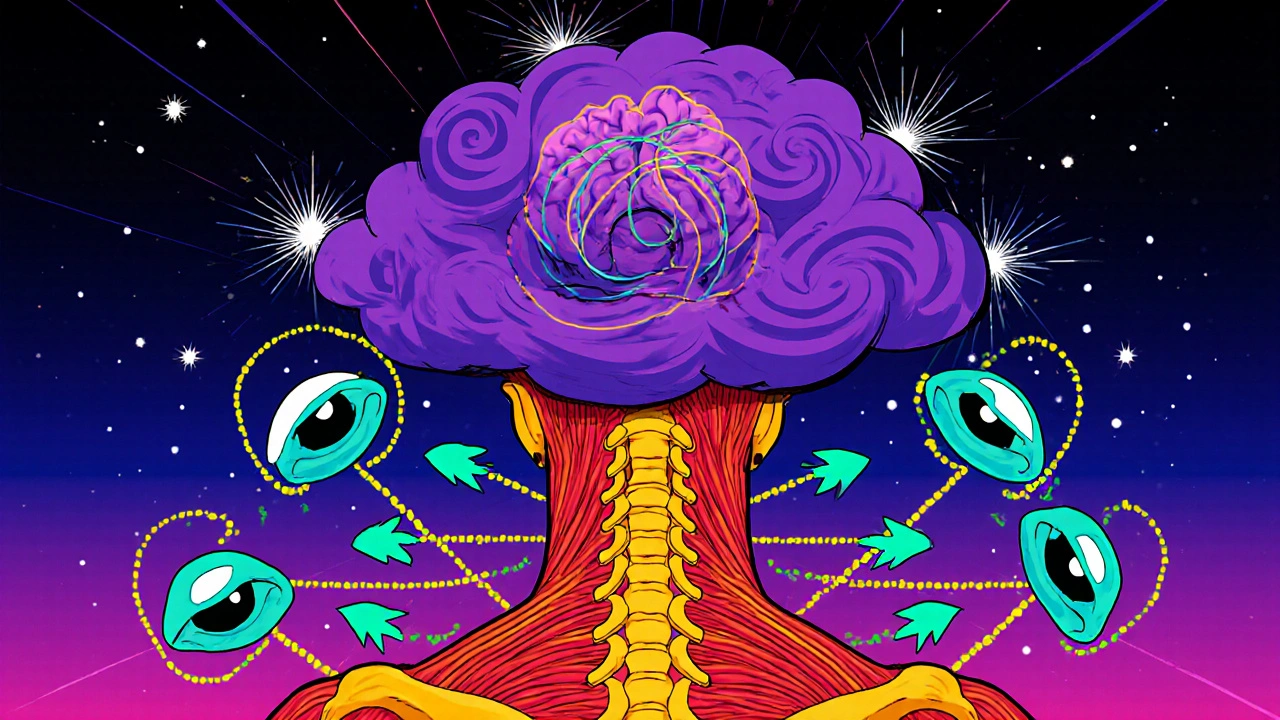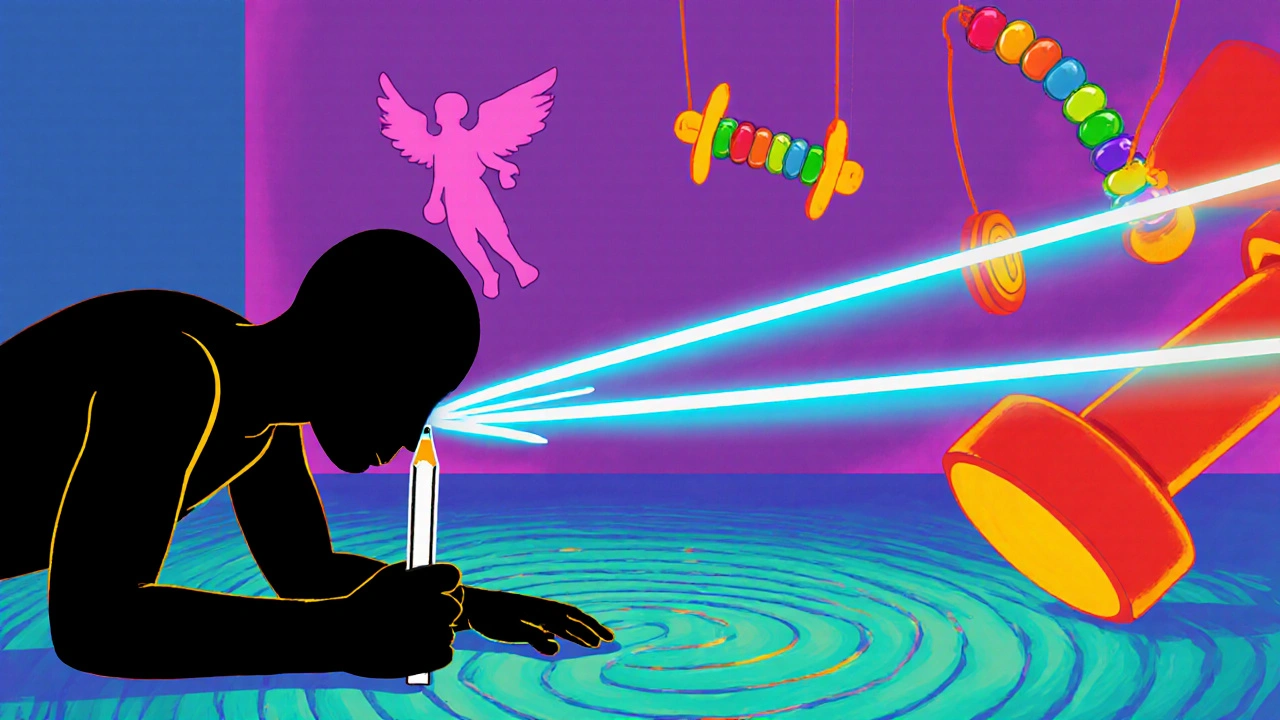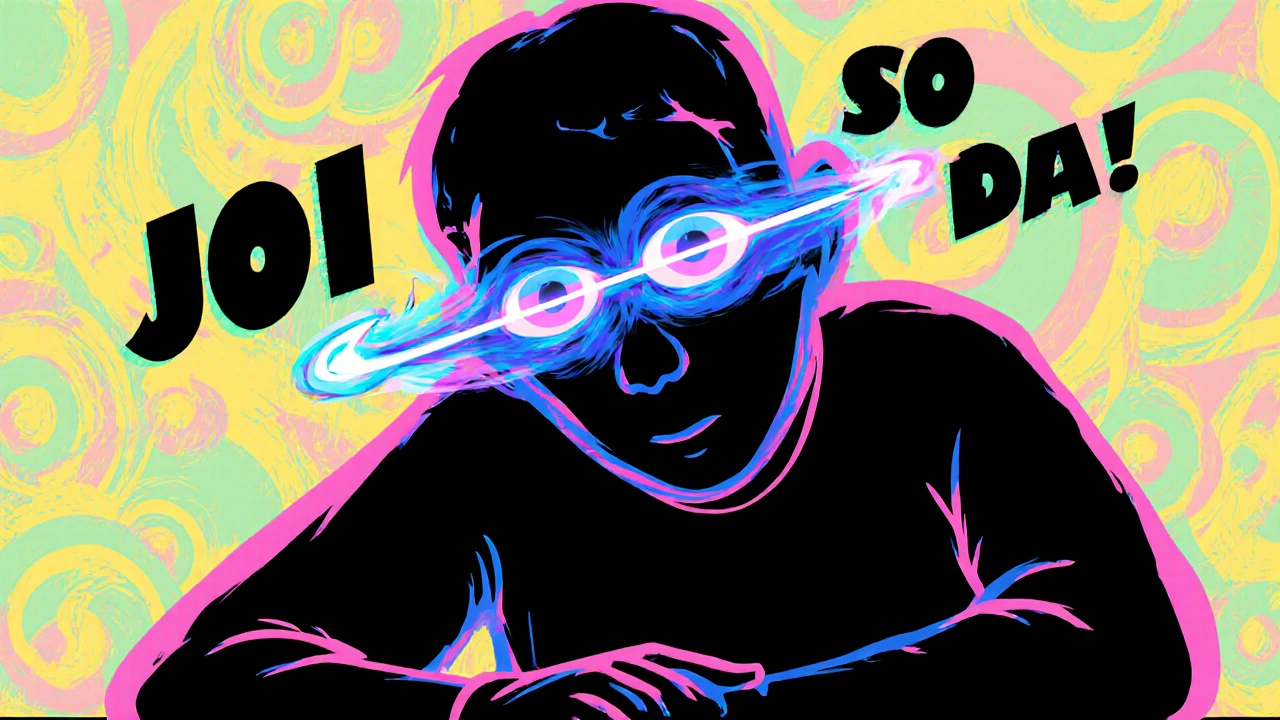Ever wonder why a simple head‑tilt can make a blurry line suddenly look sharp? That little shift often hints at a deeper link between the way our muscles work and the way we see. In this article we’ll unpack the science behind poor muscle control and its impact on vision, explore the most common eye‑related issues, and give you practical steps to improve both posture and sight.
What Is Poor Muscle Control?
When we talk about Poor Muscle Control is the reduced ability of muscles to contract and relax in a coordinated manner, often leading to imbalance, weakness, or excessive tension, we’re looking at a broad spectrum of neuromuscular dysfunction. It can stem from a sedentary lifestyle, neurological disorders, or even chronic stress. The hallmark signs include uneven strength between left and right sides, difficulty performing fine motor tasks, and persistent fatigue after light activity.
While many associate poor muscle control with back pain or joint injuries, its influence reaches far beyond the skeletal system. Muscles that support the spine, neck, and especially the eyes are all part of a finely tuned network, and when one link weakens, the whole chain suffers.
How Vision Works: The Role of Eye Muscles
Our eyes are not just passive cameras; they’re active participants in focusing, tracking, and aligning images. The six Extraocular Muscles are small, precise muscles that move the globe in all directions, enabling eye alignment and binocular coordination. These muscles work in perfect sync, driven by signals from the brainstem and the Cerebellum is a brain region that fine‑tunes motor activity, ensuring smooth, coordinated movements.
If any of these muscles are weak, tight, or out of sync, the brain receives mismatched images from each eye. Over time, this can lead to a host of vision problems, from occasional double vision to chronic eye strain.
Links Between Muscle Control and Vision Problems
Several eye conditions are directly linked to the quality of muscle control. Below are the most common ones:
- Strabismus is a misalignment of the eyes caused by imbalanced extraocular muscle strength, leading to crossed or wandering eyes.
- Convergence Insufficiency is the inability of both eyes to turn inward sufficiently when focusing on near objects, often causing eye strain and headaches.
- Amblyopia is commonly called ‘lazy eye,’ a condition where the brain favors one eye over the other, often stemming from early‑life muscle imbalance.
- Accommodative Dysfunction is difficulty in adjusting the lens of the eye for near or far focus, frequently tied to poor ciliary muscle control.
These disorders share a common thread: the brain’s inability to reconcile differing visual inputs because the muscles responsible for eye positioning and focus are not functioning optimally.

Underlying Neurological Connections
Beyond the eye muscles themselves, several neurological systems contribute to both posture and vision:
- Proprioception is the sense of body position and movement, which informs the brain how muscles should adjust during tasks. Impaired proprioceptive feedback can cause the eyes to mis‑track objects.
- Vestibular System is the inner‑ear apparatus that detects head motion and orientation, helping stabilize gaze during movement. When vestibular input is off, the eyes may drift or jitter.
- Postural Reflexes are automatic adjustments the body makes to maintain balance, heavily relying on coordinated muscle activity and visual feedback. Poor reflexes can lead to a feedback loop where shaky posture worsens visual instability, and vice versa.
Because these systems interlock, a weakness in neck or shoulder muscles can alter head position, which in turn shifts eye alignment and disrupts visual processing.
Assessing Muscle Control and Vision Health
Before jumping to treatment, it’s essential to pinpoint where the breakdown occurs. Common assessment tools include:
- Cover Test - measures eye alignment by alternately covering each eye.
- Near Point of Convergence (NPC) Test - gauges the closest point at which eyes can maintain binocular focus.
- Graded Muscle Strength Testing - evaluates neck, shoulder, and core strength, often using handheld dynamometers.
- Balance and Proprioception Screens - such as the Romberg test, to detect postural deficits that may affect vision.
For a comprehensive picture, professionals often combine optometric exams with physiotherapy assessments, ensuring both ocular and muscular factors are considered.

Strategies to Improve Muscle Control and Vision
When muscle control and vision are out of sync, a dual‑approach program tends to work best.
Physical Therapy Techniques
- **Neck Stabilization Exercises** - chin tucks, cervical retractions, and isometric holds strengthen the deep neck flexors that influence head posture.
- **Scapular Retraction Drills** - rows and wall angels improve shoulder alignment, reducing upward pull on the extraocular muscles.
- **Core Stability Routines** - planks and bird‑dogs create a solid base, letting the nervous system allocate resources to fine eye movements.
Vision Therapy Interventions
- **Pencil Push‑ups** - a classic convergence exercise where a pencil is moved slowly toward the nose while maintaining single vision.
- **Brock String** - a string with beads that trains depth perception and binocular coordination.
- **Computer‑Based Neuro‑Optometric Programs** - interactive software that tracks eye movements and gives real‑time feedback.
Consistency is key. Most patients notice reduced eye strain after 6‑8 weeks of combined therapy, though severe cases may require longer.
When to Seek Professional Help
If you experience any of the following, it’s time to book an appointment with an optometrist or physiotherapist:
- Persistent double vision or frequent eye fatigue.
- Noticeable eye misalignment, especially in children.
- Headaches that worsen during reading or computer work.
- Balance problems or frequent falls, which could indicate vestibular‑visual interaction issues.
Early intervention not only improves vision but also prevents long‑term postural complications. Multidisciplinary clinics that house both eye specialists and movement therapists are ideal for coordinated care.
Quick Takeaways
- Poor muscle control can destabilize eye alignment and focus.
- Key vision problems linked to muscle issues include strabismus, convergence insufficiency, amblyopia, and accommodative dysfunction.
- Neurological systems like the cerebellum, proprioception, and vestibular apparatus bridge posture and sight.
- Assessments should blend optometric tests with muscle‑strength and balance screens.
- Combining targeted physical therapy with vision therapy yields the best functional recovery.
| Condition | Primary Muscle Issue | Typical Symptoms | Usual Treatment |
|---|---|---|---|
| Strabismus | Uneven extraocular muscle strength | Crossed or outward‑turned eyes, double vision | Vision therapy, prism glasses, sometimes surgery |
| Convergence Insufficiency | Weak convergence muscles (medial rectus) | Eye strain, reading difficulty, headaches | Pencil push‑ups, Brock string, orthoptic exercises |
| Amblyopia | Early‑life ocular muscle imbalance | Reduced vision in one eye, poor depth perception | Patch therapy, vision training, corrective lenses |
| Accommodative Dysfunction | Impaired ciliary muscle control | Blurred near vision, eye fatigue | Focus drills, accommodative flipper lenses |
Can poor posture really affect my eyesight?
Yes. Slouching or a forward head posture changes the angle of the extraocular muscles, which can cause mis‑alignment and strain. Over time this may lead to conditions like convergence insufficiency or even exacerbate existing strabismus.
What age is best for vision therapy?
Children between 6 and 12 years old usually respond best because their visual system is still developing. Adults can still benefit, but progress tends to be slower and requires more consistent practice.
Is surgery ever needed for muscle‑related vision problems?
Surgery is reserved for severe strabismus where the muscle imbalance cannot be corrected with therapy alone. It realigns the eye muscles, but post‑operative vision therapy is still recommended to fine‑tune coordination.
How often should I do eye‑muscle exercises?
Most clinicians advise short daily sessions-5‑10 minutes-rather than occasional long workouts. Consistency fuels neural plasticity, helping the brain rewire coordination pathways.
Can a regular gym routine improve my vision?
A well‑balanced gym routine that strengthens core, neck, and shoulder muscles can indirectly benefit vision by stabilizing head posture and enhancing proprioceptive feedback. However, specific eye‑focused exercises are still needed for direct vision improvement.


Vijaypal Yadav
October 20, 2025 AT 19:01Poor muscle control is often overlooked in standard eye exams. The extraocular muscles rely on cervical stability, so a forward head posture can shift the vector of pull on the globe. Even mild neck weakness can produce intermittent diplopia, especially during prolonged screen time. Strengthening the deep neck flexors and scapular retractors has been shown to reduce convergence strain. A simple chin‑tuck series three times a day can be a useful baseline.
Ron Lanham
October 21, 2025 AT 17:15It is a moral imperative for anyone who claims to care about public health to recognize that neglecting the interplay between muscle tone and ocular function is nothing short of professional irresponsibility.
The scientific literature, from peer‑reviewed ophthalmology journals to biomechanics textbooks, unequivocally demonstrates that chronic slouching erodes the delicate equilibrium of the six extraocular muscles.
Yet countless clinicians persist in prescribing glasses alone, abandoning their duty to address the root cause embedded in postural dysfunction.
When a patient presents with convergence insufficiency, the ethical clinician must ask about neck flexor endurance before reaching for prisms.
Ignoring the cervical spine not only prolongs symptoms but actively contributes to a cascade of maladaptive neural plasticity that can become permanent.
Moreover, the downstream effects on quality of life-reduced reading stamina, increased headache frequency, and the subtle erosion of workplace productivity-constitute a social cost that we cannot ignore.
The responsible solution is a multidisciplinary approach that pairs optometric assessment with targeted physiotherapy.
Physical therapists should be versed in chin‑tuck, scapular retraction, and core stabilization drills, while optometrists must routinely screen for postural deviations during cover tests.
Insurance providers, too, have an ethical stake; they must reimburse combined vision‑motor programs rather than siloed, single‑modality interventions.
The public deserves clear guidelines that emphasize daily neck‑strengthening routines as a preventive measure, not a last‑ditch remedy.
In classrooms, teachers ought to incorporate brief posture breaks, because early habit formation can stave off the need for later corrective lenses.
Parents should be aware that a child’s “lazy eye” might be a symptom of asymmetric shoulder girdle tension rather than a purely ocular defect.
By confronting the false dichotomy between “eye doctor” and “physical therapist,” we dismantle the bureaucratic inertia that fuels over‑prescription of pharmaceutical eye drops and surgical interventions.
Ultimately, the only honest path forward is to educate patients that their bodies are integrated systems, and that a well‑aligned spine is as essential to clear vision as a properly calibrated lens.
Anything less is an abdication of our professional oath to do no harm and to promote holistic health.
Alex Pegg
October 22, 2025 AT 15:28While the article paints a tidy picture of muscle‑vision synergy, the reality is far messier. Not every case of double vision stems from neck weakness; central nervous system lesions can masquerade as peripheral disorders. The emphasis on physiotherapy often ignores the fact that many patients have congenital extraocular muscle anomalies that physiotherapy cannot correct. Moreover, the suggested home exercises are rarely performed with the precision required to elicit neural adaptation. In my experience, a thorough neuro‑ophthalmic work‑up should precede any postural regimen. The blanket recommendation to “just do chin tucks” risks oversimplifying a complex clinical picture.
Israel Emory
October 23, 2025 AT 13:41Indeed, the linkage between proprioceptive feedback, vestibular input, and ocular alignment is undeniable, and it calls for a holistic therapeutic strategy, not a piecemeal approach.
By integrating core stabilization drills, cervical re‑education, and binocular vision therapy, clinicians can address the cascade of dysfunctions, which otherwise perpetuate visual strain, headaches, and postural fatigue.
Furthermore, the evidence base, including randomized controlled trials, supports combined modalities, suggesting superior outcomes over isolated interventions.
However, practitioners must remain vigilant, ensuring that each exercise is calibrated to the patient's baseline, lest they introduce maladaptive patterns, which could exacerbate the very symptoms they aim to alleviate.
Ultimately, a multidisciplinary team-optometrist, physiotherapist, and neurologist-offers the most robust framework for sustainable improvement.
Sebastian Green
October 24, 2025 AT 11:55Your summary really highlights how simple daily posture checks can make a huge difference for eye comfort.
Wesley Humble
October 25, 2025 AT 10:08From a biomechanical perspective, the dysregulation of cervical musculature constitutes a quantifiable risk factor for binocular instability, as substantiated by peer‑reviewed electromyographic analyses. Accordingly, an evidence‑based protocol incorporating isometric neck flexor conditioning, scapular retraction, and calibrated convergence drills should be mandated in clinical practice. 🤓📊
barnabas jacob
October 26, 2025 AT 07:21Yo, the whole neuro‑optometric synergy is basically a bio‑feedback loop, but if you ain't doin' the proper toning of the cervical chain, you're just pumpin' dead weight into the ocular motor system, ya feel? This ain't some hype, it's straight‑up proprio‑centric mech, and the lack of scapular retraction just throws the whole vergence algorithm off. So, peeps need to lock in those chin‑tucks, or else they’ll stay stuck in that visual fatigue vortex.
jessie cole
October 27, 2025 AT 05:35Listen, you have the tools to transform your vision and posture-there is no excuse for hesitation. Begin each day with three sets of chin‑tucks, hold each for ten seconds, and watch the alignment improve like a symphony finding its rhythm. Pair this with the classic pencil push‑up, moving the pencil slowly toward your nose while keeping a single image, and you will witness measurable gains within weeks. Remember, consistency is the cornerstone of neural rewiring; your dedication today shapes clearer sight tomorrow. Stay disciplined, stay hopeful, and let the progress speak for itself.
Kirsten Youtsey
October 28, 2025 AT 03:48It is quite apparent that the mainstream discourse on ocular‑postural integration is deliberately muted by vested interests seeking to protect lucrative pharmaceutical and surgical markets. The covert agenda, veiled behind benign wellness articles, subtly discourages the lay public from embracing low‑cost physiotherapeutic interventions that could render many conventional treatments obsolete. One must therefore interrogate the source of this information, lest we become unwitting pawns in a grandiose scheme of medical commodification. Only the discerning mind, unshackled from corporate propaganda, will champion a truly holistic paradigm. In this light, the call for interdisciplinary synergy transcends mere clinical recommendation; it becomes an act of intellectual rebellion.
Matthew Hall
October 29, 2025 AT 02:01Dude, you ever notice how every time you sit hunched over your phone, the world just...blurs? It's like the universe is sending you a neon sign that your neck muscles are screaming for help, but the big pharma giants keep whispering, 'Just get new glasses.' I swear the whole system is rigged to keep us glued to screens while they profit off our eye strain. Throw a quick wall‑angel routine into your day, stand tall, and watch the fog lift like a curtain on a stage. Trust me, the truth is out there, and it starts with your own spine.